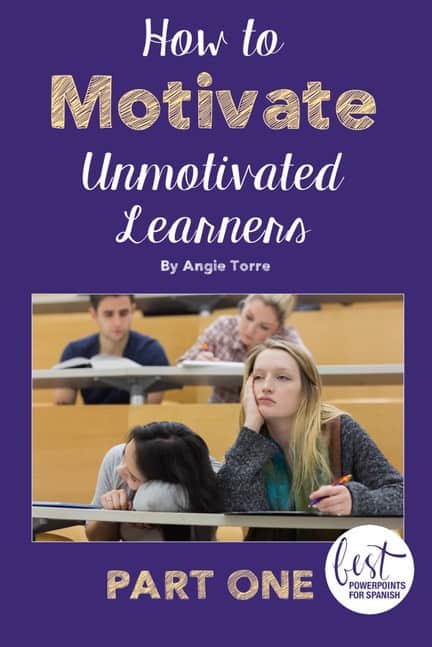How to Motivate Unmotivated Learners- Part One
How to Motivate Students
For the past six years I have been teaching upper-level Spanish classes, including AP Spanish, working with highly-motivated students. In order to sharpen my skills so that I could give my students the best education possible, I read in Spanish daily, researched complex grammar concepts, and scoured the internet for relevant listening activities.

During that time, my instructional skills for lower-level classes got a little rusty. I forgot how to motivate students.
Spanish One students have different needs and it took me a while to get that ship sailing smoothly. Some of these students don’t do homework just because you assign it or pay attention just because they are sitting in your classroom. Part of my job is to motivate students to want to perform as instructed. Here’s how I do that.
TIP #1 FREQUENT ASSESSMENTS
I did two interactive notebook checks in Spanish Two, one at semester time and one right before finals. If I want my Spanish One students to keep their notebook organized and completed, I need to check it weekly. Every Friday I randomly choose a page in their notebook to grade. My T.A. uses a rubric and quietly goes around the room checking the notebooks according to the rubric. Here is the rubric: Interactive Notebook Weekly Rubric
I break up all the vocabulary and concepts into smaller pieces and test more frequently. This keeps students hopping.
By the way, If you haven’t used Interactive Notebooks in your classes but are curious about them, here is a short video that shows my Master Spanish Two INB.
In case you missed my previous blogs about it, you can click here: How to Use Interactive Notebooks in the World Language Classroom.
TIP #2 SMALL CHUNKS
I teach for five to ten minutes and immediately give students a practice activity (check for understanding) to reinforce what they just learned. I use white boards, interactive notebook activities, TPR (Gets students moving), question / answer and other activities. Longer segments of direct instruction require more mental focus and risk disengagement.
TIP #3 POSITIVE PEER PRESSURE
Many of my closure activities involve positive peer pressure. This influence holds students accountable but doesn’t humiliate them.
For example, while Team A is writing the answers, Team B is throwing a ball into a box. Every time the ball falls into the basket, Team B gets a point. Team A can’t stop the opponents from scoring until EVERY STUDENT on their team has correctly written the answer. This is a favorite game of my students. If you would like to know how to play it, click here: Ball Throwing Game When planning my closure activities, I try to include activities that require positive peer pressure and collaboration.
TIP #4 COLLABORATION
In the above example, in order to win, students need to collaborate. During most competitions I say, “Ayúdense”, or, “Ayúdenlo”. Students know what that means and hustle to help each other.
Most of my closure activities are team competitions which, by their nature, require collaboration unless it is disallowed. They also motivate students who typically strive to win regardless of their enthusiasm for the subject.
TIP #5 NO PASSES
Once students know how to say, “No sé” they think they now are off the hook. I tell my students they can say, “No sé” or, “Je ne sais pas,” from time to time if the concept is difficult. However, most of the time they must answer. If they don’t know the answer I’ll wait. Until they get out the handout they are supposed to have in front of them. Until they engage. Until other students help them. Peer pressure again. “¡Ayúdenla!”. Students soon learn they can’t turn their brains off because you’ll wait. And wait.
TIP #6 REMIND
OK, it’s another form of, “Nag, nag, nag”. But it works. I post my homework on Schoology every day with helps, attached documents, examples, etc. But not all students check the website. But ALL students check their phones. Constantly. So, I post the homework on https://www.remind.com. Sometimes I post twice a day. (It’s a bit like twitter in that you have to be succinct. That’s not always possible.)
I asked students how many of them checked REMIND. Most hands went up. Then I asked how many checked Schoology. Fewer students raised their hands.
Over the past holiday week I posted a message congratulating students on their last test scores and reminding them to keep up the good work by doing their homework.
Click on the following link to read Part TWO of HOW TO MOTIVATE UNMOTIVATED LEARNERS. There are so many effective strategies I couldn’t fit them all into one blog. It’s been a very educational few months.
HAPPY TEACHING! I hope you had a restful break. As always, I appreciate any ideas you have about how to motivate students. Feel free to share on this blog or on my Facebook page: Best PowerPoints for Spanish
If you found these tips useful and would like to read more, make sure to subscribe to my mailing list. If you know other teachers who would benefit from subscribing, make sure to share the link to this website. Scroll down to subscribe: Best PowerPoints and More for Spanish and French
SaveSaveSaveSave


